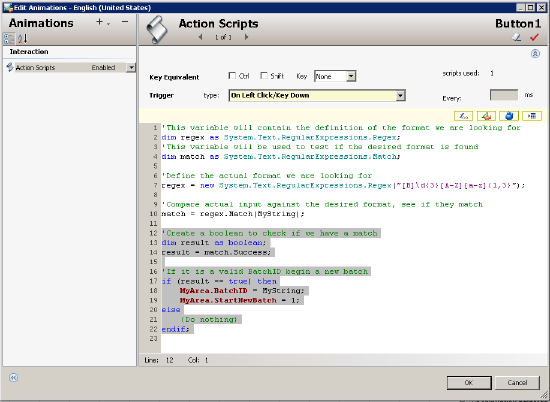TN AG115 Validate User Input with Regular Expressions (RegEx)

Description
Regular Expressions are a way to compare a value to see if it is in a particular format. This can be useful to validate user input to ensure it is formatted correctly.
- Author: Dillon Perera
- Published: 12/31/2015
- Applies to: ArchestrA Symbols with InTouch
Details
To use Regular Expressions we will make use of the .NET System.Text.RegularExpressions library.
The following lines of script are the basic format we will use to validate input, replacing the FORMATSTRING with the required format, and MyString with the variable we are trying to validate.
'This variable will contain the definition of the format we are looking for
dim regex as System.Text.RegularExpressions.Regex;
'This variable will be used to test if the desired format is found
dim match as System.Text.RegularExpressions.Match;
'Define the actual format we are looking for
regex = new System.Text.RegularExpressions.Regex("FORMATSTRING");
'Compare actual input against the desired format, see if they match
match = regex.Match(MyString);
Details on how to format a Regular Expression's string can be found online. The following MSDN page gives a number of examples: https://msdn.microsoft.com/en-us/library/ae5bf541(v=vs.90).aspx
Example:
User is requested to enter a Batch ID. We know that for this company all Batch IDs must begin with a capital B, followed by three digits, a single uppercase character indicating the product code, then 1-3 lowercase letters indicating the country it is going to.
We will now build the regular expression:
| Rule | Equivalent in Regular Expression Syntax |
| Must start with capital B | [B] - indicating we're looking for 1 character that must be 'B' |
| Three digits | \d{3} - \d indicates a number, {3} is the quantity |
| A single uppercase letter | [A-Z] - indicates we'll accept a character between A and Z. |
| 1 to 3 lowercase letters | [a-z]{1,3} - indicates we'll accept a character between 'a' and 'z', and the {1,3} indicates we allow 1 to 3 characters. |
So the final regular expression will be "[B]\d{3}[A-Z][a-z]{1,3}".
In our ArchestrA symbol we might create an Action Script similar to the following (Highlighted lines show differences from original script) to only process the next batch if we have received a valid BatchID.
'This variable will contain the definition of the format we are looking for
dim regex as System.Text.RegularExpressions.Regex;
'This variable will be used to test if the desired format is found
dim match as System.Text.RegularExpressions.Match;
'Define the actual format we are looking for
regex = new System.Text.RegularExpressions.Regex("[B]\d{3}[A-Z][a-z]{1,3}");
'Compare actual input against the desired format, see if they match
match = regex.Match(MyString);
'Create a boolean to check if we have a match
dim result as boolean;
result = match.Success;
'If it is a valid BatchID begin a new batch
if (result == true) then
MyArea.BatchID = MyString;
MyArea.StartNewBatch = 1;
else
{Do nothing}
endif;
With this code, the script will compare the BatchID entered by the user against the existing format. Below are some examples of potential input, and if they would be accepted:
| Input from User | Accepted? | If not, why? |
| B712Ausa | Yes | |
| A615Ausa | No | Begins with an 'A', not a 'B' |
| b123Bcdn | No | Begins with a lowercase 'b', not uppercase 'B' |
| B123Bcdn | Yes | |
| BabcCusa | No | After the 'B' there are letters instead of numbers |
| B51Dusa | No | After the 'B' there are only two numbers, not three |
| B517Dusa | Yes | |
| B517DUSA | No | The last three letters are uppercase, not lowercase |


